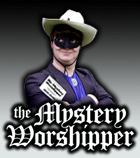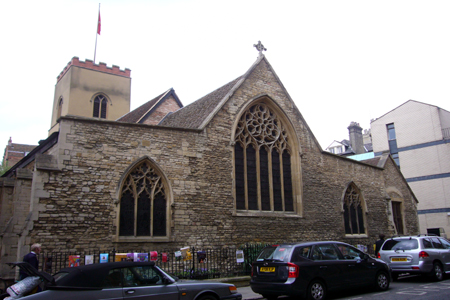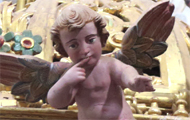| |
 |
 |
 |
| Comment on this report, or find other reports. |
 |
| Our Mystery Worshippers are volunteers who warm church pews for us around the world. If you'd like to become a Mystery Worshipper, start here. |
 |
| Find out how to reproduce this report in your church magazine or website. |
|
|
| 2101: St Edward
King and Martyr, Cambridge, England |
 |
 Photo: Magnus Manske
Photo: Magnus Manske
|
 |
Mystery
Worshipper: AJH.
The church: St
Edward King and Martyr, Peas Hill, Cambridge, England.
Denomination:
Church
of England, Diocese
of Ely.
The building:
A compact 15th century Gothic pile. Inside it's wide and spacious,
including north and south chapels for two Cambridge colleges,
Trinity Hall and Clare Hall, respectively. It is nicely decorated,
not fussy, with stained glass and various plaques.
The church:
St Edwards, sometimes called Teddy’s, is known as the
cradle of the English Reformation, for it was here on Christmas
Eve in 1525 that Robert Barnes, one of the Cambridge men who
were wont to gather at the White Horse Tavern for Bible reading
and theological discussion, delivered a sermon criticising the
church. Brought before Cardinal Wolsey, Barnes was given the
choice of imprisonment or burning at the stake. Preferring neither,
he escaped to Europe, where he met Martin Luther. He eventually
returned to England but his Lutheran ways were too much for
Henry VIII, who in 1540 saw to it that he was burned after all.
St Edward's has recently become a centre for meditative Christianity.
There are also regular Gothic eucharists on alternate Tuesday
evenings, featured on a separate
website. These are candlelit services with a customised
liturgy. Looks interesting.
The neighbourhood: The
church lurks amongst the shops, colleges and cafés of
the centre of the university town of Cambridge, enclosed in
railings and its own small churchyard, providing an oasis of
quiet amidst the commercial bustle.
The cast: The
presider was the Revd Dr Fraser Watts, chaplain. The Revd Dr
Malcolm Guite, associate chaplain, was the preacher (and poet).
The date & time: Sunday,
24 October 2010, 11.00am.
What was the name of the service?
Dedication Festival and Baptism.
How full was the building?
There were about 40 people in total, not obviously empty but room for many more. It's one of those churches with very short pews where anyone sitting in a pew discourages others from sharing it and you feel you've got to ask permission, because you're invading their personal space.
Did anyone welcome you personally?
Hymnbooks and service sheet were handed to us on entry without
any particular greeting. There are lots of pillars restricting
view, so we moved to the front and asked a lady in the pew behind
if it was reserved for anyone. She replied, "Reserved?
No!" This was encouraging.
Was your pew comfortable?
No! Narrow and very upright. Fortunately there was plenty to distract us from this.
How would you describe the pre-service
atmosphere?
Quiet and serene apart from occasional noises from one or two
children (probably for the baptism).
What were the exact opening words of the
service?
"Good morning and a very warm welcome." (Actually the church wasn't warm but rather chilly.)
What books did the congregation use during the
service?
Hymns Ancient and Modern New Standard, with melody (the melody was useful because I didn't know some of the tunes). Book of Common Prayer (used only for a psalm). Duplicated service sheet.
What musical instruments were played?
Organ.
Did anything distract you?
Sitting at the front, we were removed from distractions by those
behind us, apart from occasional noises. There was a splendid
stained glass window ahead of us.
Was the worship stiff-upper-lip, happy clappy, or
what?
Traditional but enthusiastic. It sounded as though those immediately behind us meant what they were saying.
Exactly how long was the sermon?
6 minutes.
On a scale of 1-10, how
good was the preacher?
9 – He was not only a preacher, but also a poet.
In a nutshell, what was
the sermon about?
Following Genesis 28:10-17, the story of Jacob's ladder, the sermon linked this to the dedicated place of the church, appropriate to the dedication festival. The ladder touches both earth and heaven, but is at best a gate, in fact a gate to the human heart. In our hearts there is a pulpit, a lectern, a font and a communion table. This gives us a picture of the beauty of the human heart.
Which part of the service was like being in
heaven?
Most of it! Malcolm Guite had written four sonnets about Latimer's
pulpit (Hugh Latimer, one of the key figures of the English
Reformation, preached from this pulpit and was martyred in 1555),
the lectern, the font and the communion table; he read each
of these at their location. An anthem, "Locus Iste"
by Anton Bruckner, was beautifully sung by five singers. Even
the plainsong invocation "In this temple", chanted
by the presider, was strangely moving.
And which part was like being in... er... the other place?
The pews could have been designed by those people who design
bus shelters, who presumably imagine that buses really do come
along every minute! Deep enough for extremely small people only.
And it was a bit chilly, but the other place doesn't have that
reputation!
What happened when you hung around after the service looking lost?
No one spoke to us at all without us making the first move.
"Tea or coffee? Milk? Sugar?" was about the extent
of the unsolicited conversation. However, I said hello to the
priest and we looked around at the windows and the plaques.
How would you describe the after-service
coffee?
It was instant coffee in cup and saucer, and the biscuits were not bad.
How would you feel about making this church your regular (where 10 = ecstatic, 0 = terminal)?
7 – Judging from the list of services, there is great variety.
Although very keen on 1662 Book of Common Prayer apparently,
there was no suggestion of slavishly following it. I suspect
you couldn't easily get bored here.
Did the service make you feel glad to be a
Christian?
Yes.
What one thing will you remember about all this in seven days' time?
The art and creativity in the service: poetry, anthem, plainsong. |
|
|
 |
 |
 |
| We rely on voluntary donations to stay online. If you're a regular visitor to Ship of Fools, please consider supporting us. |
 |
 |
 |
| The Mystery Pilgrim |
 |
| One of our most seasoned reporters makes the Camino pilgrimage to Santiago de Compostela in Spain. Read here. |
 |
 |
 |
| London churches |
 |
| Read reports from 70 London churches, visited by a small army of Mystery Worshippers on one single Sunday. Read here. |
| |
|
|
|
|


